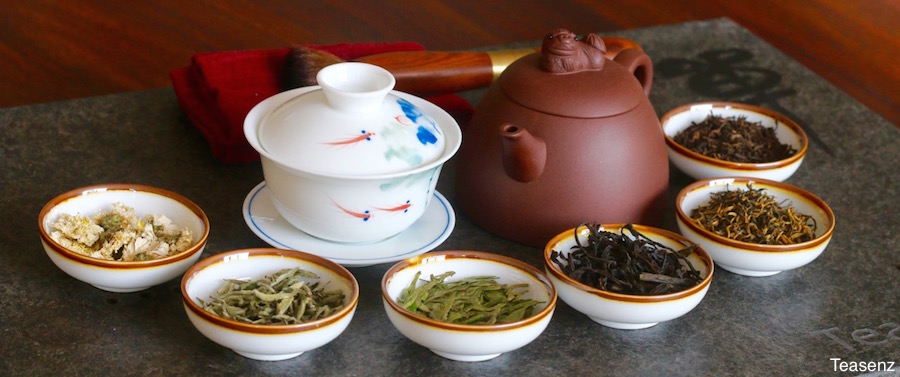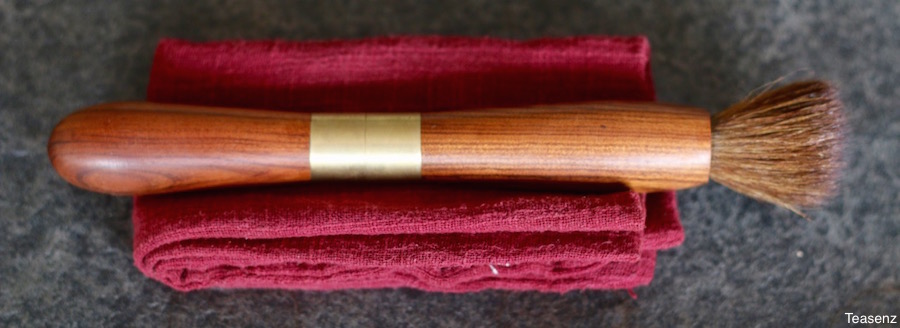Porcelain gaiwans and Yixing teapots are definitely the most popular tools to gongfu brew Chinese tea. If you're planning to invest in such teaware, make sure to read this guide first! You'll learn everything you need to know for a more informed buying decision.
In fact, gaiwans and Yixing pots aren’t really enemies. They’re friends who have one thing in common: an endless thirst for good tea. However, they both have their strengths and weaknesses, and by learning about them, you’ll find out what’s the ideal vessel for your tea.
Look how peaceful the lazy tiger (on teapot) and the fishes (on gaiwan) look together in the picture below :)

In this guide, we’re going to compare these two tea tools based on the materials used. This will be followed by a discussion on which teas are the most suitable for each type of teaware. Afterwards, you’ll learn more about the steeping and tasting experience of gaiwans versus Yixing teapots. We’ll then end this guide with a short note on pricing and some final tips.
Material: Yixing Zisha vs Porcelain
The material is probably the most significant factor in comparing teaware. Yixing ceramics are made from zisha clay (also called Yixing clay). The porous nature of the clay allows it to absorb a tiny bit of tea with every single use. And over time, this will allow the teapot to enhance the flavors and aromas. Though this sounds great, the downside of this is that you should always dedicate your Yixing teapot to one kind of tea.
Also read:
8 Yixing Teapot Features You Should Know About
On the other hand, gaiwans are generally made from porcelain (or another type of ceramic). Porcelain is very dense and won’t affect the flavor of your teas at all. Therefore, you don’t have to dedicate one to a certain tea type.
Note: both teapots and gaiwans can be made from different material. However, in this comparison we narrow the scope to porcelain gaiwans and yixing teapots, because these are the types of teaware that are generally used for gongfu brewing.
Tea Appreciation: Which teas are suitable?
Now that you know about the features of Yixing clay versus porcelain, we could now look into the type of teas that are suitable.
Green, white and yellow teas
As we said above, the porcelain material of a gaiwan won’t affect the flavor of your tea. Thus, it’s suitable for any kind of tea. However, it’s especially popular as a steeping tool for green, yellow and white teas. That’s because these tea types have a light flavor with delicate aromas, which are less compatible with clay pots. For a better appreciation of these teas, a gaiwan will be your choice.
Oolong, black and pu erh teas
For oolong, black and pu erh tea. Gaiwans can still be a good idea, if you’re want to evaluate and compare teas. For instance, your tasting teas before you’re ready to buy. In such situation, you don’t want to be bias by a taste enhancing Yixing pot. In addition, Gaiwans have the advantage that you’ll be better able to observe the leaves inside. At last, another common tea appreciation practice is to smell the fragrance of tea from the lid after steeping.
Because gaiwans are great for tea appreciation, we highly recommend when you’re just in the beginning phase of learning about tea. Be patient with investing in your first Yixing steeper, as you still need to find out which teas you love the most. For that purpose, gaiwans are better teachers.
A gaiwan is also your preferred choice when you plan to steep herbal or artificially flavored & colored teas. You really don’t want your zisha pot to absorb those, as this will negatively affect other teas you steep after.
At last, with some more light oolong with a floral aroma such as the Tie Guan Yin, appreciating it in a gaiwan can also make more sense relative to Yixing teapots. Yet, opinions differ among tea lovers. Tie Guan Yin teas can benefit from the better heat isolation of Yixing teapots.
In any other situation, Yixing zisha teapots are superior. Given that you have the time to enjoy a full tea ceremony style gongfu brewing, which brings us to the next topic that you need to consider: time & steeping experience.
Time & Steeping
Drinking tea is a very personal experience. Some tea lovers like to take the time, while others plan quick tea sessions to get their daily tea fix. If time is your friend, then an Yixing teapots is the best option to go for if you own a tea table. Gongfu brewing with Yixings is fun, but it can become messy when you pour hot water over your zisha teapot. A tea table will catch the water and drain it through a small tube.
Seasoning & Raising an Yixing Teapot
Another reason why time is crucial is because a zisha teapot needs to seasoned first before use and afterwards it needs to be ‘raised’. Besides just using it regularly, you need to rinse and dry it with a soft cloth or brush it with a tea brush.

If the above sounds time consuming to you, then Yixing teaware probably isn’t something for you. If it sounds fun, then absolutely go for it.
Gaiwans are efficient steepers & but don't burn your hands!
Gaiwans are more efficient steeping tool. You can steep tea in a matter of seconds without the need for a tea table. The only things you’ll need is a pitcher (with a strainer) and a cup. However, if you plan to drink from the gaiwan, then you don’t need anything else. Though the tea might get bitter. But you can easily avoid this, steep it without the lid on and apply a lower water temperature. It’s kind of like drinking green tea in a straight glass.
A disadvantage that should be mentioned is that it’s easy to burn your hands while using a gaiwan. Especially if you’re unexperienced, There are simply on shortcuts when it comes to mastering a gaiwan, but the video will show you a few tips and tricks.
Pricing guide
Yixing teapots are available in many different prices, but don’t expect to find a good one below 150 USD in a retail store or below 50 USD when you buy it from us direct from China. We’ve been sourcing teapots in Yixing for many years, and our experience tells us that anything below that budget won’t be worth your money. We don’t like to call these ‘fake’, but it’s just that you’ve good and bad clay. And below that budget, the clay quality is rarely good.
So given that you’ll need to spend quite a significant amount of money on a zisha teapot and given that you’ll have to dedicate it to one tea type, an Yixing teapot will make tea appreciation a pretty expensive hobby. And as said you’ll even need to invest in a small tea table or buy this together as a Yixing tea set with a tea table included.
Yixing value appreciation
The good thing to know is that buying an Yixing teapot isn't like buying a car. The value of the teapot will increase over time, given that you take good care of it. Generally, owners of Chinese teapots serve tea to guests in teapots that they want to raise and resell at a higher value in the future. Of course, this might be less easy if you're not an owner of a teashop. And if you've developed a certain connection with your Yixing pottery, you won't let it go easily.
Gaiwans & affordability
If investing in Yixing sounds just way to excessive for you, then luckily gaiwans are pretty cheap. In our store, you buy a gaiwan online for just 15 USD!
What's important is that you should check the size of the gaiwan first before you buy. Most gaiwans in our online store will fit 160 ml / 5.4 oz, because we believe this is the best all-round size to go for.
If you're in a local tea shop, you'll also be able to check the density of the porcelain. This is important because cheap and light gaiwans might not maintain their shape well. There's no rule of thumb for this. If the lightness is due to the fact that the gaiwan is made very thin, this could still mean that it's good craftsmanship. However, a thick gaiwan that still feels like in the hand could mean trouble.
Conclusion
So to summarize, you should go for Yixing teapot if:
- You’ll enjoy a full gongfu ceremony
- If you’ve a tea table available
- If your favorite brews are oolong, black and pu erh teas.
- If you’ll enjoy raising an Yixing pot.
- If you’ve the budget to buy and dedicate an Yixing teapot to different teas.
You should go for a gaiwan:
- If you want a casual and efficient steeper.
- If you generally drink green, yellow and/or white tea.
- When you want to evaluate, appreciate and compare teas in their most neutral state.
- If you don't want to dedicate teaware to specific teas and don't want to spend too much money on teaware.